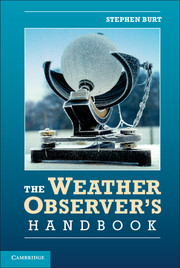Book contents
- Frontmatter
- Contents
- Acknowledgements
- Abbreviations, footnotes and references
- Part One The basics
- Part Two Measuring the weather
- 5 Measuring the temperature of the air
- 6 Measuring precipitation
- 7 Measuring atmospheric pressure
- 8 Measuring humidity
- 9 Measuring wind speed and direction
- 10 Measuring grass and earth temperatures
- 11 Measuring sunshine and solar radiation
- 12 Observing hours and time standards
- 13 Dataloggers and AWS software
- 14 Non-instrumental weather observing
- 15 Calibration
- 16 Metadata – what is it, and why is it important?
- Part Three Making the most of your observations
- Appendix 1 Metrology and meteorology: The basics of instrument theory
- Appendix 2 Useful functions
- Appendix 3 Unit conversions
- Appendix 4 Useful sources
- Index
- References
12 - Observing hours and time standards
Published online by Cambridge University Press: 05 July 2012
- Frontmatter
- Contents
- Acknowledgements
- Abbreviations, footnotes and references
- Part One The basics
- Part Two Measuring the weather
- 5 Measuring the temperature of the air
- 6 Measuring precipitation
- 7 Measuring atmospheric pressure
- 8 Measuring humidity
- 9 Measuring wind speed and direction
- 10 Measuring grass and earth temperatures
- 11 Measuring sunshine and solar radiation
- 12 Observing hours and time standards
- 13 Dataloggers and AWS software
- 14 Non-instrumental weather observing
- 15 Calibration
- 16 Metadata – what is it, and why is it important?
- Part Three Making the most of your observations
- Appendix 1 Metrology and meteorology: The basics of instrument theory
- Appendix 2 Useful functions
- Appendix 3 Unit conversions
- Appendix 4 Useful sources
- Index
- References
Summary
For weather measurements to be comparable between different locations, the time (or times) at which observations are made, and the period covered by the measurements, should be common as far as possible. WMO provides guidance on observation times for the main international synoptic observing networks, while ‘climatological’ observing practice tends to be defined at a country or regional level. It is outside the scope of this book to provide detailed guidance on all aspects of standard climatological observing practice for every country in the world, so this chapter outlines common observing routines, based around a once-daily morning observation. Examples based upon current practice within the United States, UK and Ireland are given where these illustrate generally applicable principles. The importance of common time standards and common time period/s for once-daily values, such as maximum temperature or total rainfall, are stated, and the meaning, relevance and importance of ‘terminal hours’ is introduced.
Country-specific details on observing practices, including standard observing hours and ‘terminal hours’, can be found in the websites or publications of the world’s state meteorological services listed on the WMO website [1].
- Type
- Chapter
- Information
- The Weather Observer's Handbook , pp. 271 - 281Publisher: Cambridge University PressPrint publication year: 2012



